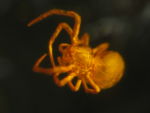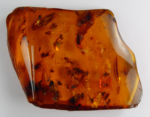Amber and inclusions
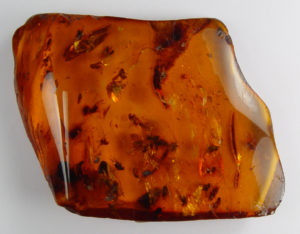
Amber is fossil resin. The oldest resin dates back to the Carboniferous and is consequently more than 300 million years old. In the case that resin sticks to a surface, for example to the trunk of a tree, occassionally animals or plants get caught. In some lucky cases the following flow of resin enclosed these remains and the inclusions outlast million of years. Inclusions like these do not occur before the Triassic, somewhat more than 200 million years ago. According to this there are several different types of amber that exist, occuring in different periods of the Earth’s History. In the northern European realm the Baltic amber is the most important fossil resin. Most of the inclusions housed in the Geosciences Collection originate from this resin that is about 35-40 million years old.
Baltic amber
The Baltic amber is resin from conifers and is usually attributed to a single species (Pinus sucifera). In the late Eocene, about 35-40 million years ago, the amber forest that produced this resin, was distributed over large parts of Scandinavia and the recent Baltic Sea (green colour in the figure). Shortly after the deposition shipping of amber out of the amber forest started. At first million of amber specimens were transported by marine currents to the present-day Kaliningrad Oblast in Russia and the neighbouring areas in eastern Poland (green outline), later the sea, rivers (red ouline) as well as the glaciers of the ice-ages (blue arrows) transported the amber up to eastern England and way south to northern Germany.
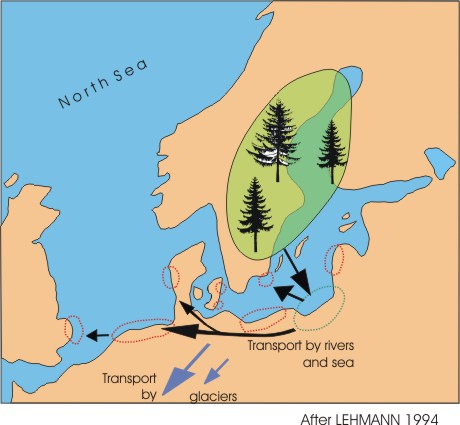
- Lehmann, J. (1994): Mineralien aus Rheine und Umgebung. – Rheine gestern, heute, morgen 32(2/93): 6-15.
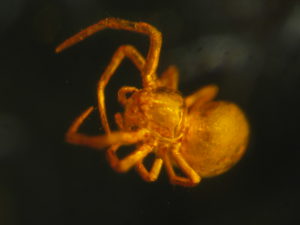
Collection of inclusions
TheGeosciences Collection houses about 80 amber specimens with inclusions. This comprises of the remains of plants as well as those of animals. Among the plant fossils there are records of conifers as well as broad-leafed trees. Most of the fossil animals are insects, for example beetles, butterflies, hymenopterans (ants, bees and wasps), flies as well as grasshoppers, katydids and crickets. Furthermore spiders and crustaceans are recorded by fossils. Outstanding specimens are the only fully-grown tick preserved in Baltic amber and fecal pellets of termites that were described by Weidner (1956). The following chart gives an overview of the groups of organisms that are recorded as fossils in the collection:
| Inclusions of animals | Class/order (English term) |
Class/order (scientific term) |
Group of animal |
| beetles | Coleoptera | ||
| butterflies | Lepidoptera | ||
| Ants, bees, wasps | Hymenoptera | ||
| Flies | Diptera | ||
| Grasshoppers, katydits, crickets | Orthoptera | Orthopterans, Termites, Cicadas | |
| Spiders, scorpions | Arachnida | Havestmen, Weaving spiders, Ticks | |
| Crustaceans | Crustacea | Isopods | |
| Inclusions of plants | Class/order (English term) |
Class/order (scientific term |
|
| Conifers | Coniferophyta | ||
| Broad-leafed trees | Dicotyledonae |
Only three specimens of our collection were part of the collection of the Übersee-Museums already before the second world war, all others were purchased after 1959. A part of the material was bought at the Amber manufacture in Hamburg, some specimens were purchaed by Dr. T. Kruckow in Berlin. The majority of inclusions, however, came from Dr. Weiss who was professor of physiology. The latter were bought for the collection of the Übersee-Musem in Bremen by Dr. T. Kruckow in 1955 from his widdow.
- Weidner, H. (1956): Kotballen von Termiten im Bernstein. – Veröffentlichungen aus dem Übersee-Museum in Bremen: 363-365.

